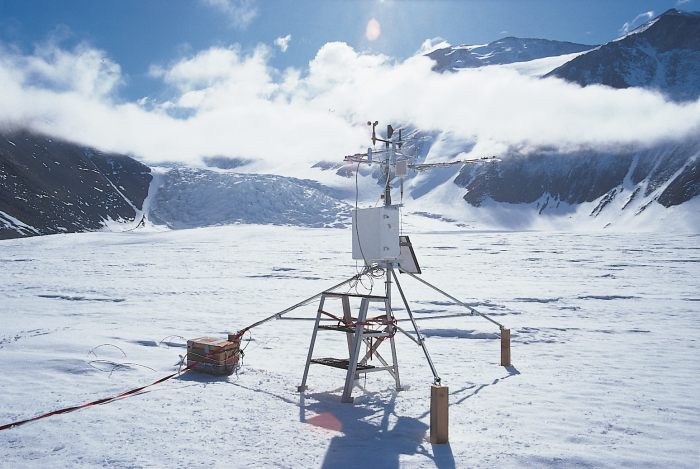


全米科学財団が後援する長期生態学研究 (LTER) プログラムは、さまざまな環境における生態学的現象を監視します。このプログラムは、地球上で最も過酷な砂漠の 1 つであるマクマード ドライ バレーにある最新のサイトを含む、北米の 16 か所と南極の 2 か所のサイトをサポートしています。ロバート ウォートン ジュニア博士 (DRI) が率いるマクマード LTER は、最も寒く、最も乾燥したサイトです。
この研究では、乾燥谷の生態系に対する物理的および生物学的制約の影響と、これらの生態系に対する物質輸送の影響という 2 つのプロセスを理解しようとしています。
すべての生態系は気候と物質輸送によって形作られますが、このことが最も顕著に表れるのは乾燥した谷間です。夏の数週間は気温が氷点下を超え、氷河が溶けて一時的な小川や一年中氷に覆われた湖が生まれます。この期間は生命維持に不可欠です。なぜなら、ほとんどの物質輸送 (有機炭素、栄養素、堆積物) がこの期間に発生するからです。
この厳しい環境に生息する生物は、一般の観察者には分かりません。微細な植物や生物は、氷河の小さな融解池(クリオコナイトの穴)、一時的な川底、氷で覆われた湖、土壌に隠れています。
研究の最初のステップの 1 つは、生物学的環境と生理化学的環境の間の複雑な相互作用を記録するためのデータ収集ネットワークを確立することでした。
乾燥谷の厳しい気象条件は、データ収集に特有の課題をもたらします。機器は、極端な気温や風、4 か月間の太陽光発電の停止、長期間のメンテナンスなしに耐えなければなりません。さらに、多様な気象条件には、他の LTER サイトで一般的な単一の観測所ではなく、気象ネットワークが必要です。
3 回目のフィールド シーズン (1996 年 2 月) の終了までに、マクマード LTER 自動気象ネットワーク (LAWN) を構成する 11 のCampbell Scientific 気象観測所を運用する予定です。これらの観測所のうち 6 つは湖岸にあり、4 つは地元の氷河に木製の支柱で設置されています。これには、エネルギー バランスの研究に役立つ渦相関観測所も含まれます。
McMurdo LTER では、以下のものを継続的に測定する CR10 ベースのシステムも運用しています。
- 3つの氷に覆われた湖の水位、温度、導電率
- 14の河川の流量、導電率、温度
- 温暖化実験におけるさまざまな深さの土壌温度
マクマード LTER は合計で 30 機以上の CR10 と 2 機の 21X を運用しています。
将来的には、これらのステーションはマクマード基地 (東約 100 km) にリアルタイム データを送信し、インターネット経由でアクセスできるようになります。このデータは、修理やアップグレードの計画に役立ち、Radarsat (最近打ち上げられたカナダの衛星) の画像と地表の状況を比較するために使用されます。
ケーススタディの概要
アプリケーション
乾燥谷の生態系に対する物理的および生物学的制約の影響、および物質輸送がこれらの生態系に与える影響に関する研究。場所
マクマードドライ谷、南極使用製品
21X CR10寄稿者
Peter Doran, graduate research assistant, biological sciences, Desert Research Institute (DRI), Reno, Nevada参加団体
国立科学財団計測項目
氷結した湖の水位、温度、導電率、土壌温度、河川の流量、導電率、温度、渦相関係数関連ウェブサイト
McMurdo LTER Home PagePDFで見る